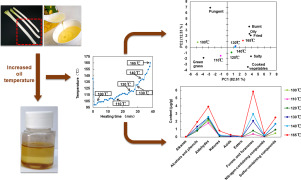当前位置:
X-MOL 学术
›
Food Res. Int.
›
论文详情
Our official English website, www.x-mol.net, welcomes your feedback! (Note: you will need to create a separate account there.)
Flavor formation in frying process of green onion (Allium fistulosum L.) deep-fried oil.
Food Research International ( IF 7.0 ) Pub Date : 2019-03-08 , DOI: 10.1016/j.foodres.2019.03.006 Ning Zhang 1 , Baoguo Sun 1 , Xueying Mao 2 , Haitao Chen 3 , Yuyu Zhang 4
Food Research International ( IF 7.0 ) Pub Date : 2019-03-08 , DOI: 10.1016/j.foodres.2019.03.006 Ning Zhang 1 , Baoguo Sun 1 , Xueying Mao 2 , Haitao Chen 3 , Yuyu Zhang 4
Affiliation

|
Fried allium oil has been widely used in traditional Chinese home cooking and recently has grown in popularity in the food manufacturing industry. Thus, physical and chemical changes during frying process were measured to investigate the flavor formation mechanism in green onion (Allium fistulosum L.) deep-fried oil. With the increase of the oil temperature, important variations took place when the temperature rose above 140 °C during the whole frying process. A detailed study of these changes was made from both macro and micro aspects. From a macro perspective, sensory attributes including burnt, fried, oily, cooked vegetable and salty were strengthened. Meanwhile, the reference points of the oil samples on the fingerprint chart were distinguishable from others by electronic nose. In addition, contents of furans and furanones, sulfur-containing compounds, aldehydes and alcohols increased sharply according to SAFE-GC-MS analysis from a microscopic point of view, and contents of unsaturated fatty acids dropped remarkably while the saturated ones increased. These changes were considered to be caused by interactions between carbohydrates, proteins and fats in the deep-fried system and thermo degradations of sugars, amino acids and fats. The results indicated that the stage, when frying at temperatures ranging from 140 °C to 165 °C, was the most significant period for the flavor formation of the deep-fried oil.
更新日期:2019-03-08







































 京公网安备 11010802027423号
京公网安备 11010802027423号